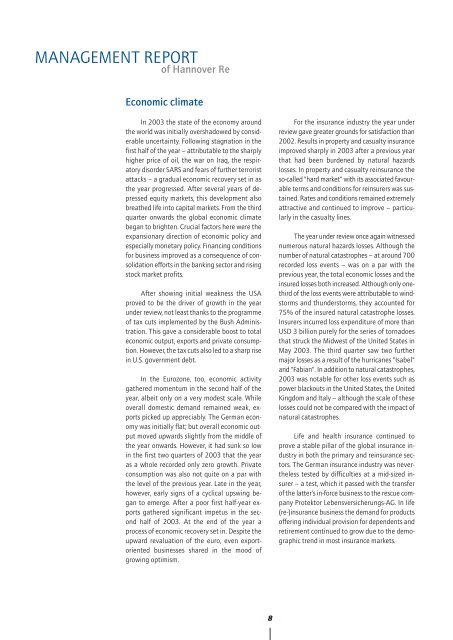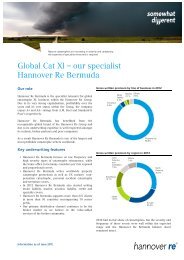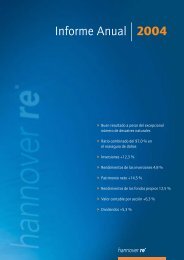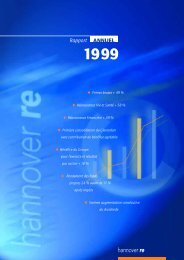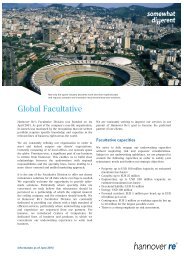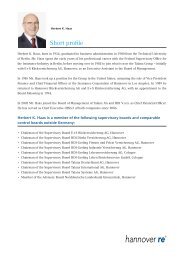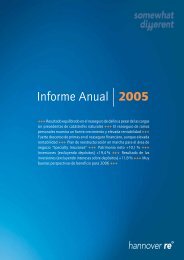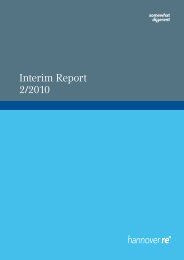Annual Report 2003 - Hannover Re
Annual Report 2003 - Hannover Re
Annual Report 2003 - Hannover Re
You also want an ePaper? Increase the reach of your titles
YUMPU automatically turns print PDFs into web optimized ePapers that Google loves.
MANAGEMENT REPORT<br />
of <strong>Hannover</strong> <strong>Re</strong><br />
Economic climate<br />
In <strong>2003</strong> the state of the economy around<br />
the world was initially overshadowed by considerable<br />
uncertainty. Following stagnation in the<br />
first half of the year – attributable to the sharply<br />
higher price of oil, the war on Iraq, the respiratory<br />
disorder SARS and fears of further terrorist<br />
attacks – a gradual economic recovery set in as<br />
the year progressed. After several years of depressed<br />
equity markets, this development also<br />
breathed life into capital markets. From the third<br />
quarter onwards the global economic climate<br />
began to brighten. Crucial factors here were the<br />
expansionary direction of economic policy and<br />
especially monetary policy. Financing conditions<br />
for business improved as a consequence of consolidation<br />
efforts in the banking sector and rising<br />
stock market profits.<br />
After showing initial weakness the USA<br />
proved to be the driver of growth in the year<br />
under review, not least thanks to the programme<br />
of tax cuts implemented by the Bush Administration.<br />
This gave a considerable boost to total<br />
economic output, exports and private consumption.<br />
However, the tax cuts also led to a sharp rise<br />
in U.S. government debt.<br />
In the Eurozone, too, economic activity<br />
gathered momentum in the second half of the<br />
year, albeit only on a very modest scale. While<br />
overall domestic demand remained weak, exports<br />
picked up appreciably. The German economy<br />
was initially flat; but overall economic output<br />
moved upwards slightly from the middle of<br />
the year onwards. However, it had sunk so low<br />
in the first two quarters of <strong>2003</strong> that the year<br />
as a whole recorded only zero growth. Private<br />
consumption was also not quite on a par with<br />
the level of the previous year. Late in the year,<br />
however, early signs of a cyclical upswing began<br />
to emerge. After a poor first half-year exports<br />
gathered significant impetus in the second<br />
half of <strong>2003</strong>. At the end of the year a<br />
process of economic recovery set in. Despite the<br />
upward revaluation of the euro, even exportoriented<br />
businesses shared in the mood of<br />
growing optimism.<br />
For the insurance industry the year under<br />
review gave greater grounds for satisfaction than<br />
2002. <strong>Re</strong>sults in property and casualty insurance<br />
improved sharply in <strong>2003</strong> after a previous year<br />
that had been burdened by natural hazards<br />
losses. In property and casualty reinsurance the<br />
so-called "hard market" with its associated favourable<br />
terms and conditions for reinsurers was sustained.<br />
Rates and conditions remained extremely<br />
attractive and continued to improve – particularly<br />
in the casualty lines.<br />
The year under review once again witnessed<br />
numerous natural hazards losses. Although the<br />
number of natural catastrophes – at around 700<br />
recorded loss events – was on a par with the<br />
previous year, the total economic losses and the<br />
insured losses both increased. Although only onethird<br />
of the loss events were attributable to windstorms<br />
and thunderstorms, they accounted for<br />
75% of the insured natural catastrophe losses.<br />
Insurers incurred loss expenditure of more than<br />
USD 3 billion purely for the series of tornadoes<br />
that struck the Midwest of the United States in<br />
May <strong>2003</strong>. The third quarter saw two further<br />
major losses as a result of the hurricanes "Isabel"<br />
and "Fabian". In addition to natural catastrophes,<br />
<strong>2003</strong> was notable for other loss events such as<br />
power blackouts in the United States, the United<br />
Kingdom and Italy – although the scale of these<br />
losses could not be compared with the impact of<br />
natural catastrophes.<br />
Life and health insurance continued to<br />
prove a stable pillar of the global insurance industry<br />
in both the primary and reinsurance sectors.<br />
The German insurance industry was nevertheless<br />
tested by difficulties at a mid-sized insurer<br />
– a test, which it passed with the transfer<br />
of the latter's in-force business to the rescue company<br />
Protektor Lebensversicherungs-AG. In life<br />
(re-)insurance business the demand for products<br />
offering individual provision for dependents and<br />
retirement continued to grow due to the demographic<br />
trend in most insurance markets.<br />
8


